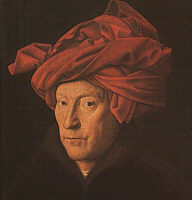
|
Jan probably came from Maaseick in the province of Limbourg. In 1422 he was working in The Hague for John of Bavaria, count of Holland. In 1425 Philip the Good, duke of Burgundy, appointed him court painter, a position he retained until his death. Jan was on especially good terms with Philip, who entrusted him with certain secret diplomatic missions, presented one of his children with a christening gift, and personally interceded for him when he learned that Jan was having trouble collecting his salary.
The uncertainty of Jan's early training makes his artistic relationship with his brother Hubert of great importance. The shadowy figure of Hubert has inspired endless speculation and debate among scholars, including one theory that he never existed. The present consensus is that he did exist and that he might have had a hand in painting some of the more problematic “Eyckian” pictures that seem to date from Jan's early career. Some of these works, ascribed variously to both Jan and Hubert or to either Jan or Hubert, are the Turin-Milan Hours (manuscript destroyed by fire in 1904), the Three Marys at the Tomb (Museum Boymans-van Beuningen, Rotterdam), and a diptych, Crucifixion and Last Judgement (Metropolitan Museum of Art, New York City). The most famous work in this category is the monumental Ghent Altarpiece (1432, Cathedral of Saint Bavon, Ghent), a polyptych whose outer panels open to reveal the Adoration of the Lamb, painted for the chapel of Jodocus Vyd. A Latin quatrain copied from this altarpiece states that Hubert began the work and Jan completed it. Art historians assume that Jan collected the painted panels that Hubert began before his death in 1426, added new ones of his own design, and assembled the whole in Vyd's chapel.
Nine paintings by Jan are still extant, carefully signed and dated, all between 1432 and 1439. Of these pictures, four depict religious subjects—including the Madonna with Canon van der Paele (1436, Groeninge Museum, Bruges)—and five are portraits, such as Giovanni Arnolfini and His Wife (1434, National Gallery, London). Although numerous unsigned panels have been attributed to him, less than a dozen of these are unquestionably by him. These works, in addition to the Ghent Altarpiece, include the Madonna and Child with Chancellor Rolin (1433-1434, Musée du Louvre, Paris) and Cardinal NicolÔ Albergati (1435?, Art History Museum, Vienna).
Jan's contemporaries were awed by his amazing technical skill and his precise renderings of carefully observed detail. These qualities explain why he was still called the King of Painters by his compatriots as late as the 16th century.
|

